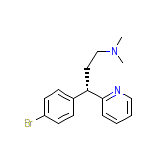Antihistamine compound




Antihistamine compound Brand names, Antihistamine compound Analogs
Antihistamine compound Brand Names Mixture
- Drixoral Cold & Sinus (Dexbrompheniramine Maleate + Pseudoephedrine Sulfate)
- Drixoral Day/Night - Srt/Tabs (Dexbrompheniramine Maleate + Pseudoephedrine Sulfate)
- Drixoral Syrup (Dexbrompheniramine Maleate + Pseudoephedrine Sulfate)
- Drixtab Tab (Dexbrompheniramine Maleate + Pseudoephedrine Sulfate)
Antihistamine compound Chemical_Formula
C16H19BrN2
Antihistamine compound RX_link
http://www.rxlist.com/cgi/pharmclips2.cgi?keyword=%20Dexbrompheniramine
Antihistamine compound fda sheet
Antihistamine compound msds (material safety sheet)
Antihistamine compound Synthesis Reference
No information avaliable
Antihistamine compound Molecular Weight
319.24 g/mol
Antihistamine compound Melting Point
No information avaliable
Antihistamine compound H2O Solubility
No information avaliable
Antihistamine compound State
Solid
Antihistamine compound LogP
3.74
Antihistamine compound Dosage Forms
Tablet
Antihistamine compound Indication
For treatment and relief of symptoms of allergies, hay fever, and colds
Antihistamine compound Pharmacology
In allergic reactions an allergen interacts with and cross-links surface IgE antibodies on mast cells and basophils. Once the mast cell-antibody-antigen complex is formed, a complex series of events occurs that eventually leads to cell-degranulation and the release of histamine (and other chemical mediators) from the mast cell or basophil. Once released, histamine can react with local or widespread tissues through histamine receptors. Histamine, acting on H1-receptors, produces pruritis, vasodilatation, hypotension, flushing, headache, tachycardia, and bronchoconstriction. Histamine also increases vascular permeability and potentiates pain. Dexbrompheniramine is a histamine H1 antagonist (or more correctly, an inverse histamine agonist) of the alkylamine class. It provides effective, temporary relief of sneezing, watery and itchy eyes, and runny nose due to hay fever and other upper respiratory allergies.
Antihistamine compound Absorption
Antihistamines are well absorbed from the gastrointestinal tract after oral administration.
Antihistamine compound side effects and Toxicity
Signs of an overdose include fast or irregular heartbeat, mental or mood changes, tightness in the chest, and unusual tiredness or weakness.
Antihistamine compound Patient Information
Antihistamine compound Organisms Affected
Humans and other mammals














